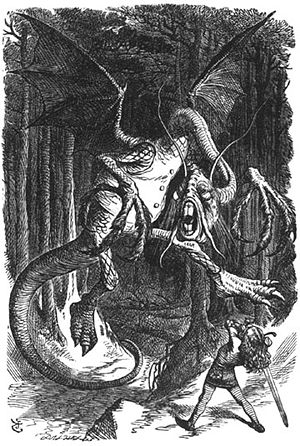
Vorpal
Encyclopedia

Lewis Carroll
Charles Lutwidge Dodgson , better known by the pseudonym Lewis Carroll , was an English author, mathematician, logician, Anglican deacon and photographer. His most famous writings are Alice's Adventures in Wonderland and its sequel Through the Looking-Glass, as well as the poems "The Hunting of the...
in his nonsense poem
Nonsense verse
Nonsense verse is a form of light, often rhythmical verse, usually for children, depicting peculiar characters in amusing and fantastical situations. It is whimsical and humorous in tone and tends to employ fanciful phrases and meaningless made-up words. Nonsense verse is closely related to...
"Jabberwocky
Jabberwocky
"Jabberwocky" is a nonsense verse poem written by Lewis Carroll in his 1872 novel Through the Looking-Glass, and What Alice Found There, a sequel to Alice's Adventures in Wonderland...
".
Context and definition
Carroll published Through the Looking-GlassThrough the Looking-Glass
Through the Looking-Glass, and What Alice Found There is a work of literature by Lewis Carroll . It is the sequel to Alice's Adventures in Wonderland...
in 1871. Near the beginning, Alice
Alice (Alice's Adventures in Wonderland)
Alice is a fictional character in the literary classic, Alice's Adventures in Wonderland and its sequel, Through the Looking-Glass, And What Alice Found There. She is a young girl from Victorian-era Britain.-Development:...
discovers and reads "Jabberwocky". The word "vorpal" appears twice in the poem, which describes a young boy's quest to slay a monster called the Jabberwock:
- He took his vorpal sword in hand:
And later,
- One, two! One, two! And through and through
- The vorpal blade went snicker-snack!
- He left it dead, and with its head
- He went galumphing back.
As with much of the rest of the poem's vocabulary, the reader is left to guess at the meaning of "vorpal" from the context. It is commonly assumed to mean "deadly" or "sharp", but could also be referring to the material of which the sword is composed. Some readers have imagined other properties the word could describe. Alexander L. Taylor points out in his Carroll biography The White Knight that "vorpal" can be formed by taking letters alternately from "verbal" and "gospel".
Carroll himself once wrote, "I am afraid I can't explain 'vorpal blade' for you—nor yet 'tulgey wood.'"
In the game Dungeons & Dragons
Dungeons & Dragons
Dungeons & Dragons is a fantasy role-playing game originally designed by Gary Gygax and Dave Arneson, and first published in 1974 by Tactical Studies Rules, Inc. . The game has been published by Wizards of the Coast since 1997...
, a Vorpal Sword is defined as a sword with the magical effect that it tends to cut off opponents' heads. This makes sense in that the poem's plot results in the hero carrying away the head of the Jabberwock.

